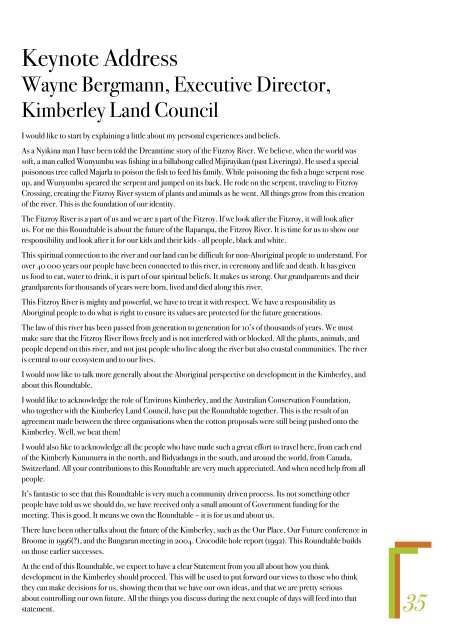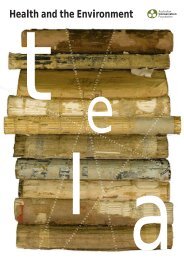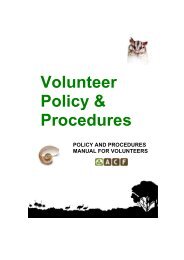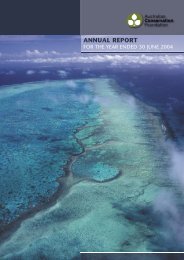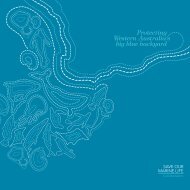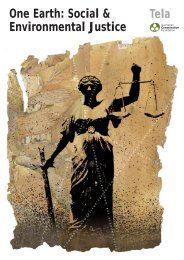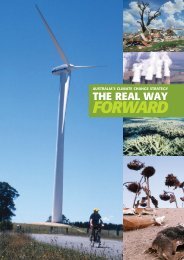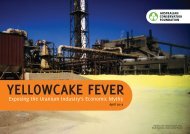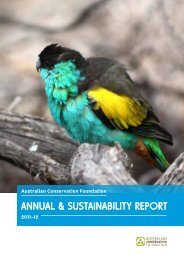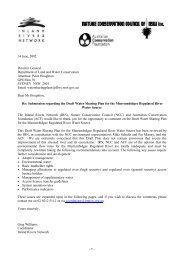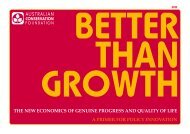Kimberley Appropriate Economics Interim Report - Australian ...
Kimberley Appropriate Economics Interim Report - Australian ...
Kimberley Appropriate Economics Interim Report - Australian ...
You also want an ePaper? Increase the reach of your titles
YUMPU automatically turns print PDFs into web optimized ePapers that Google loves.
Keynote Address<br />
Wayne Bergmann, Executive Director,<br />
<strong>Kimberley</strong> Land Council<br />
I would like to start by explaining a little about my personal experiences and beliefs.<br />
As a Nyikina man I have been told the Dreamtime story of the Fitzroy River. We believe, when the world was<br />
soft, a man called Wunyumbu was fishing in a billabong called Mijirayikan (past Liveringa). He used a special<br />
poisonous tree called Majarla to poison the fish to feed his family. While poisoning the fish a huge serpent rose<br />
up, and Wunyumbu speared the serpent and jumped on its back. He rode on the serpent, traveling to Fitzroy<br />
Crossing, creating the Fitzroy River system of plants and animals as he went. All things grow from this creation<br />
of the river. This is the foundation of our identity.<br />
The Fitzroy River is a part of us and we are a part of the Fitzroy. If we look after the Fitzroy, it will look after<br />
us. For me this Roundtable is about the future of the Raparapa, the Fitzroy River. It is time for us to show our<br />
responsibility and look after it for our kids and their kids - all people, black and white.<br />
This spiritual connection to the river and our land can be difficult for non-Aboriginal people to understand. For<br />
over 40 000 years our people have been connected to this river, in ceremony and life and death. It has given<br />
us food to eat, water to drink, it is part of our spiritual beliefs. It makes us strong. Our grandparents and their<br />
grandparents for thousands of years were born, lived and died along this river.<br />
This Fitzroy River is mighty and powerful, we have to treat it with respect. We have a responsibility as<br />
Aboriginal people to do what is right to ensure its values are protected for the future generations.<br />
The law of this river has been passed from generation to generation for 10’s of thousands of years. We must<br />
make sure that the Fitzroy River flows freely and is not interfered with or blocked. All the plants, animals, and<br />
people depend on this river, and not just people who live along the river but also coastal communities. The river<br />
is central to our ecosystem and to our lives.<br />
I would now like to talk more generally about the Aboriginal perspective on development in the <strong>Kimberley</strong>, and<br />
about this Roundtable.<br />
I would like to acknowledge the role of Environs <strong>Kimberley</strong>, and the <strong>Australian</strong> Conservation Foundation,<br />
who together with the <strong>Kimberley</strong> Land Council, have put the Roundtable together. This is the result of an<br />
agreement made between the three organisations when the cotton proposals were still being pushed onto the<br />
<strong>Kimberley</strong>. Well, we beat them!<br />
I would also like to acknowledge all the people who have made such a great effort to travel here, from each end<br />
of the Kimberly Kununurra in the north, and Bidyadanga in the south, and around the world, from Canada,<br />
Switzerland. All your contributions to this Roundtable are very much appreciated. And when need help from all<br />
people.<br />
It’s fantastic to see that this Roundtable is very much a community driven process. Its not something other<br />
people have told us we should do, we have received only a small amount of Government funding for the<br />
meeting. This is good. It means we own the Roundtable – it is for us and about us.<br />
There have been other talks about the future of the <strong>Kimberley</strong>, such as the Our Place, Our Future conference in<br />
Broome in 1996(?), and the Bungaran meeting in 2004. Crocodile hole report (1992). This Roundtable builds<br />
on those earlier successes.<br />
At the end of this Roundtable, we expect to have a clear Statement from you all about how you think<br />
development in the <strong>Kimberley</strong> should proceed. This will be used to put forward our views to those who think<br />
they can make decisions for us, showing them that we have our own ideas, and that we are pretty serious<br />
about controlling our own future. All the things you discuss during the next couple of days will feed into that<br />
statement.<br />
35


